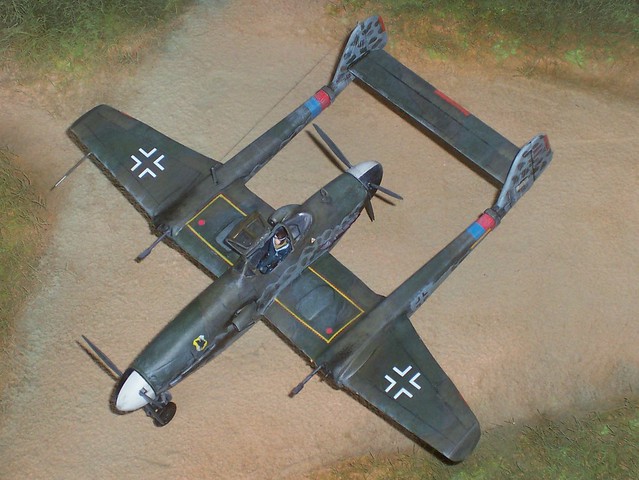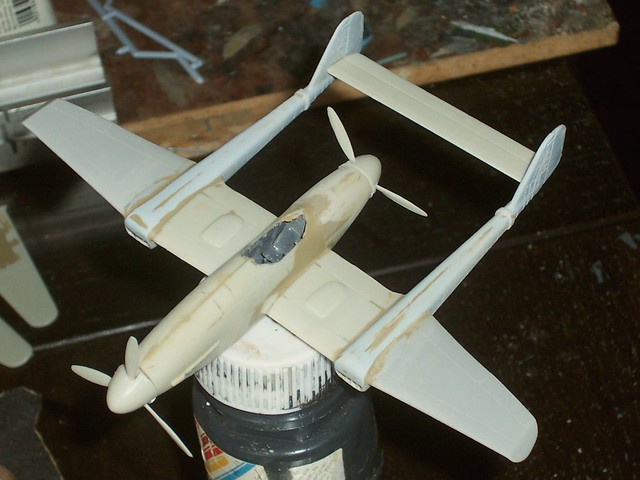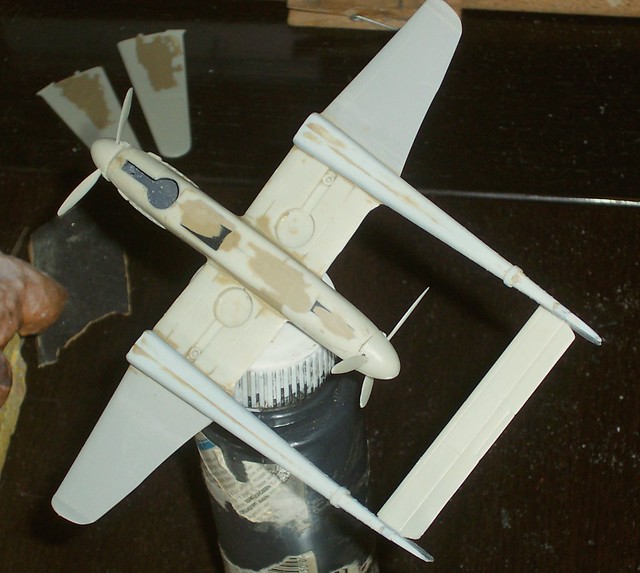Noch mal was aus der "Was-wäre-wenn"-Ecke, frisch gebacken.
Die Inspiration dazu kam von einem Whif-Bild eines ähnlichen Eigenbaus, das ich bei WWW-Recherchen gefunden hatte, und ich fand die Idee einer fortgeschrittenen Me 109 mit Zug und Druckpropeller sehr charmant - auch wenn ich bis dato keinen Hinweis finden konnte, dass so etwas geplant gewesen ist. Insofern ist es ein Whif und kein Luft '46-Modell im engeren Sinne.
Wie dem auch sei, die Idee hat mich lange nicht losgelassen, und als ich über das Me 609-Modell von HUMA gestolpert bin, hatte ich eine gute Basis: denn bis auf die Leitwerksträger ist da quasi alles drin, was man für diesen Umbau benötigt - wobei ich später die außeren Tragflächen durch kürzere einer He 162 ersetzt habe, die Originale waren dann doch sehr lang, ich wollte keinen Höhenjäger.
Das Konzept dahinter ist die Frage, wie man aus der Me 109 mehr Leistung hätte rausholen können, und dabei möglichst Teile der (erfolglosen) Me 309 und ihrer Derivate zu verwenden. Will man die Stirnfläche möglichst klein und das Flugzeug kompat halten, ist so eine Push/Pull-Anordnung fast schon logisch, auch wenn diese wiederum einige andere Probleme mit sich bringt.
Wie dem auch sei, meine Me 709 ist denn die Umsetzung, wie solch ein Entwurf hätte aussehen können, in authentischem Outfit in RLM 81/82/76 und Markierungen der VI/7. JG.
Der Huma-Bausatz ist recht rustikal und leider ziemlich simpel, da braucht man keine Scheu haben, ihn für solch einen Eigenbau zu "opfern". Die Leitwerksträger stammen von eine Airfix Fw 189, die äußeren Flügel, wie schon erwähnt, von einer He 162 (Hobby Boss). Bis auf den Piloten ist der Rest dann vom Huma-Bausatz.

1:72 Messerschmitt Me 709 A-2; „<+ – yellow“, VI/JG.7, Deutsche Luftwaffe. Personal mount of Gruppenadjutant Ferdinand Walgenbach, Teltow, Summer 1946 (Whif/Luft'46/kit bashing) by
dizzyfugu, on Flickr

1:72 Messerschmitt Me 709 A-2; „<+ – yellow“, VI/JG.7, Deutsche Luftwaffe. Personal mount of Gruppenadjutant Ferdinand Walgenbach, Teltow, Summer 1946 (Whif/Luft'46/kit bashing) by
dizzyfugu, on Flickr

1:72 Messerschmitt Me 709 A-2; „<+ – yellow“, VI/JG.7, Deutsche Luftwaffe. Personal mount of Gruppenadjutant Ferdinand Walgenbach, Teltow, Summer 1946 (Whif/Luft'46/kit bashing) by
dizzyfugu, on Flickr

1:72 Messerschmitt Me 709 A-2; „<+ – yellow“, VI/JG.7, Deutsche Luftwaffe. Personal mount of Gruppenadjutant Ferdinand Walgenbach, Teltow, Summer 1946 (Whif/Luft'46/kit bashing) by
dizzyfugu, on Flickr

1:72 Messerschmitt Me 709 A-2; „<+ – yellow“, VI/JG.7, Deutsche Luftwaffe. Personal mount of Gruppenadjutant Ferdinand Walgenbach, Teltow, Summer 1946 (Whif/Luft'46/kit bashing) by
dizzyfugu, on Flickr

1:72 Messerschmitt Me 709 A-2; „<+ – yellow“, VI/JG.7, Deutsche Luftwaffe. Personal mount of Gruppenadjutant Ferdinand Walgenbach, Teltow, Summer 1946 (Whif/Luft'46/kit bashing) by
dizzyfugu, on Flickr

1:72 Messerschmitt Me 709 A-2; „<+ – yellow“, VI/JG.7, Deutsche Luftwaffe. Personal mount of Gruppenadjutant Ferdinand Walgenbach, Teltow, Summer 1946 (Whif/Luft'46/kit bashing) - Detail by
dizzyfugu, on Flickr

1:72 Messerschmitt Me 709 A-2; „<+ – yellow“, VI/JG.7, Deutsche Luftwaffe. Personal mount of Gruppenadjutant Ferdinand Walgenbach, Teltow, Summer 1946 (Whif/Luft'46/kit bashing) - Detail by
dizzyfugu, on Flickr

1:72 Messerschmitt Me 709 A-2; „<+ – yellow“, VI/JG.7, Deutsche Luftwaffe. Personal mount of Gruppenadjutant Ferdinand Walgenbach, Teltow, Summer 1946 (Whif/Luft'46/kit bashing) by
dizzyfugu, on Flickr

1:72 Messerschmitt Me 709 A-2; „<+ – yellow“, VI/JG.7, Deutsche Luftwaffe. Personal mount of Gruppenadjutant Ferdinand Walgenbach, Teltow, Summer 1946 (Whif/Luft'46/kit bashing) by
dizzyfugu, on Flickr
Und noch zwei Bilder vom Rohbau - ohne Spachtelmasse geht da nix...

1:72 Messerschmitt Me 709 A-2 (Whif/Luft'46/kit bashing) - WIP by
dizzyfugu, on Flickr

1:72 Messerschmitt Me 709 A-2 (Whif/Luft'46/kit bashing) - WIP by
dizzyfugu, on Flickr
Nebenbei: erster Versuch bei den Bildern, so etwas wie Hangaratmosphäre einzufangen. Ich war zuerst skeptisch, aber dank des starken Gegenlicht-Kontrastes auf dem Hintergrund durch das geöffnete Tor sehen die Bilder interessanter und besser aus, als zunächst befürchtet?
Und zum Schluss: Eine Story gibt es auch noch!
The Messerschmitt Me 709 was a derivate of the unsuccessful German World War II Me 309 fighter project and its short-lived Zwilling descendant, the Me 609 which joined two fuselages of the Me 309 fighter prototype together to form a heavy fighter. The Me 609 project was initiated in response to a 1941 Reich Air Ministry requirement for a new Zerstörer (heavy fighter) to replace the Bf 110 in a minimum time and with minimum new parts.
In the Me 609 development phase, Messerschmitt had actually contemplated numerous twin-boom adaptations of its Bf 109 line including the Bf 109Z (which joined two Bf 109s) and the Me 409 (which used two Me 209-II aircraft). When it became clear that the Me 609 would not be cleared for service due to the progress in jet fighter development, the program was shelved - but quickly revived in 1943 when the high hopes in the jet engines were disappointed.
When it became clear that no jet fighter with a true dogfight capability would be in service on short notice, the RLM called for a high speed interceptor against high flying USAF bombers and their long range fighter escorts. The fast De Havilland Mosquito was another threat which was hard to counter with the existing types in service. A top speed of more than 750 km/h was requested, as well as a high rate of climb and a high agility for close combat. The fighter should also be easy to build and use many proven components in order to get it into service as quickly as possible.
Messerschmitt’s resulting Me 709 was basically a redesigned Me 309/609, since it was clear that only a twin-engined aircraft could meet the RLM requirements. Instead of two joined Me 309 fuselages with a new center wing section into which the two inboard wheels of the landing gear would retract, the Me 709 used a pull/push layout, very similar to the Fokker D-XXIII fighter. Main reason for this decision was the attempt to minimize drag and keep overall dimensions as compact as possible, offering only a small target. Easy single engine handling and high roll rate due to the weight masses centered along the longitudinal axis were another benefit of the concept. Additionally, the impressive results of the Dornier Do 335 development had additional influence. From this project, the Me 709's ejection seat (using pressurized air) and a mechanism to blow off the tail propeller fins in a case of emergency were incorporated.
The Me 709 kept the Me 309's tricycle undercarriage, even though the main wheels now retracted inwards into the center wing sections. The slender tail booms contained two separate radiator baths, the gun armament above them and fuel tanks. Additional tanks were located in the inner wing sections, before and aft the landing gear wells, as well as under the cockpit, where the Me 309 originally had its retractable radiator mounted. The tail booms were connected by a single horizontal stabilizer, taken straight from the Me 609. The second engine behind the pressurized cockpit (also taken from the Me 309) caused a considerable CG shift aft, so that the Me 309’s original wing main spar had to be moved backwards by almost 4' – but since the original radiator had been deleted, this caused no big problem and actually improved the field of view for the pilot.
Initially, two fighter versions of the Me 709 were planned, both single seaters and differing mainly in the outer wing sections. The 'A' series would be a highly agile fighter for medium to low heights, with a secondary use as fighter bomber for close air support. Armament was projected with four lightweight 30 mm MK 108 cannons, but since these highly effective guns were reserved for other projects like the Me 262, two of the guns were substituted with the heavier (but also more powerful) MK 103 cannons, or all four guns would be replaced by 20mm MG 151/20 cannons. The 'B' series would have a longer wing span (+3,6m/11 ft 9½ in) and reduced/lighter armament (only two MG 151/20), optimized for high altitude interceptions and reconnaissance.
An additional projected version, the Me 709 'C', would be outfitted as a fast bomber, with a semi-recessed 1.000kg bomb under the fuselage, provisions for additional lighter bombs under the tail booms, paired with the reduced gun armament and the longer wing span from the B version, but with additional fuel in integral tanks in the outer wing sections.
Two prototypes of the A and B version each were quickly assembled from existing Me 309 airframes, first flight tests took place in October 1944. Initially, the Me 709s were equipped with the Daimler-Benz DB 603G engine, but later use of the Jumo 213 engine with 2.000 hp and more was envisaged, pushing the top speed beyond 500mph/800km/h .
Flight tests were successful, even though the A fighter lacked directional stability and the high altitude B fighter would offer no real advantage compared to the simpler, single-engined Focke Wulf Ta 152. In January 1945, the RLM decided consequently to drop the B version, but the Me 709 A was to be developed further. Five additional pre-production airframes (A-0 series) were ordered and delivered until April 1945. These new machines featured, among other detail improvements, a recognizable dihedral to the outer wing sections, which also carried drooped wing tips. This proved to be a successful measure to improve stability, but the Me 709 A remained a rather nervous plane that constantly called for an attentive pilot. In this guise, the Me 709 A-1 was cleared and ordered for production. Delivery of the first serial machines took place in June 1945, and they were mainly used for home defense.
Several equipment packages (‘Rüstsätze’) were quickly developed and added to field machines. They would allow the carriage of various external loads, e .g. an ETC for a single max. 1.000kg bomb under the fuselage (R1), 2× 300l drop tanks on hardpoints under the tail booms (R2) or wooden racks with 2× 12 unguided R4M missiles under the outer wings (R3). After an initial batch of forty A-1 aircraft, R1 and R2 were incorporated into series production, which then became, with several other equipment changes, the A-2 main series. Almost all older models were brought to this standard within a few months, even though the gun armament differed considerably between individual aircraft.
All in all, a total of 243 Me 709 were built, all of them A series aircraft. By the time designs were being ironed out, the revolutionary Me 262 and Ar 234 turbojets and the introduction of more potent and reliable jet engines like the Heinkel-Hirth HeS 011 negated the need for further piston-engined fighter design and stopped further development of the Me 709.Me 709 A-2, general characteristics:Crew: 1
Length: 36 ft 1 in (11.01 m)
Wingspan: 40 ft 6½ in (12.38 m)
Height: 11 ft 11 in (3.64 m)
Wing area: 221.72 ft² (20.68 m²)
Empty weight: 10.665 lb (4.842 kg)
Loaded weight: 14.405 lb (6.540 kg)
Max. take-off weight: 18.678 lb (8.480 kg)
Maximum speed: 760 km/h (472 mph) at 6.400m (21.000 ft)
Range: 620 mi (840 km ) with internal fuel only
Service ceiling: 36,000 ft (10.970 m)
Rate of climb: 4.635 ft/min (23,6 m/s)
Wing loading: 29.8 lb/ft² (121.9 kg/m²)
Power/mass: 0.24 hp/lb (0.39 kW/kg)
Engine:
2× Daimler-Benz DB 603G inverted V-12 liquid-cooled piston engine, 1,287 kW (1,726 hp) each
Armament:
Varied, but typically four cannons in the front of the tail booms. Typically, 2× 30 mm (1.18 in) MK 103 cannons with 50 RPG and 2× 30 mm (1.18 in) MK 108 cannons with 110 RPG were fitted; additionally up to 1.000 kg of external loads, including bombs, drop tanks and R4M unguided missiles.